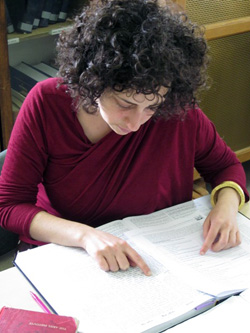By Avigail Hurvitz-Prinz

JERUSALEM–About a month ago my Talmud class did an exercise where we shared our reasons for studying Gemora. Everyone had their own reasons, and my list came up to a total of 21 reasons as wide ranging as “intellectual challenge” and “to have a sense of the Rabbinic world” or “to find myself a teacher” – but the top of that list was empowerment.
As an adult who first seriously encountered this quintessential Jewish book one-on-one only a few months ago, building skills in Jewish text study was one of my major goals when I came to learn at The Pardes Institute of Jewish Studies this fall. I wanted to know how to access sources, make sense of them in relation to each other and answer how it is that the Jewish world we live in came to be the way that it is. Imagine my surprise when, at the beginning of the semester, I was actually learning a few different Hebrews all at once (Tanakhic and Mishnaic Hebrew) decoding a new typeface (Rashi script) and a whole new language, Aramaic! My limited modern Hebrew was only minimally helpful. Thankfully, every day my chevruta (my learning partner) and I get a little practice and I get a little more familiar with where to go for help. And you need lots of help when you’re a beginning Talmud student!
First stop, the dictionaries. Is this a technical Talmud term? If yes, turn to Frank (The Practical Talmud Dictionary by Rabbi Yitzchak Frank). If not, try the Jastrow (A Dictionary of the Targumim, the Talmud Bavli, Talmud Yerushalmi and Midrashic Literature by Marcus Jastrow). Is the little snippet of what you’re learning right now mentioned? Yes? Well, then, dingdingding! You’ve just found a Jastrow Jackpot and you and your chevruta should high-five across the table. But if you didn’t find your answer in Jastrow, try your neighbors who are in a level above you. The Beit Midrash study hall is a cooperative place, where learning happens not just from teachers but from fellow students – and hopefully they can help to point you in a good direction. Interruptions are part of the fun of learning in the Beit Midrash and the place has a totally different atmosphere than the silent library carrels of my undergraduate days. The Beit Midrash at Pardes is also an incredible place for its uniqueness among the landscape of yeshivot and midrashot – men and women learn together. There are times when I forget just how radical that is – but the truth of the matter is that women have not had consistent access to these Jewish texts for very long, nor is it commonplace for us to be able to sit with male learning partners. At Pardes that is the norm, and it still strikes me as hugely important to the community’s ethos.
The more I learn, the more I realize how much more there is to know. I have spent the last nine months learning only the most basic tools of what is intended as a lifelong endeavor. I’m lucky for the time I have spent finally doing Jewish learning not just from handouts prepped by informal Jewish educators like me, but straight through a chapter of Masechet Megilla and all of the tidbits it contained. Among my gleanings: the answer for why we repeat a verse in the special Torah reading for the new month, sources for why women may or may not read Torah publicly (depending on your interpretation of the sources) and some insights into behaviors Jews in the Mishnaic period considered heretical (round Tefillin or dressing like “separatists” only in white or wearing no shoes!). Many of these gleanings are interesting to me anthropologically, as they describe the history of Jewish practice. But even more important to me than some of the particular facts I’ve learned is the way I am able to simply open the page and make my way through the Talmud, albeit slowly and with lots of support. My work is not done, but my pursuit of Jewish literacy got a huge boost from the time I have spent at Pardes. Learning from my teachers, my peers and from the sources has been an invaluable way to spend my year – and one whose treasures I look forward to discovering as my Jewish journey continues.
*
Avigail Hurvitz-Prinz learned at Masa Israel’s Pardes in 2010-2011. Avigail grew up in San Diego County, the daughter of two Reform rabbis, attendED Reed College where she graduated with a degree in Religion and subsequently worked as Senior Assistant Dean of Admission. From January 2008 until her time at Pardes, Avigail worked as a program associate on Hazon’s Food Programs.
Pingback: These and Those » Blog Archive » Alumna Published!